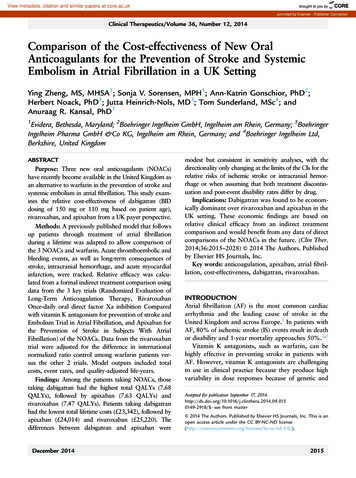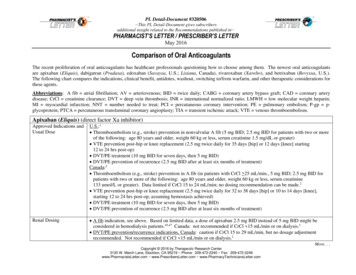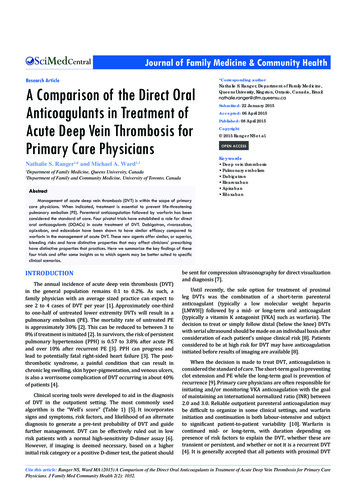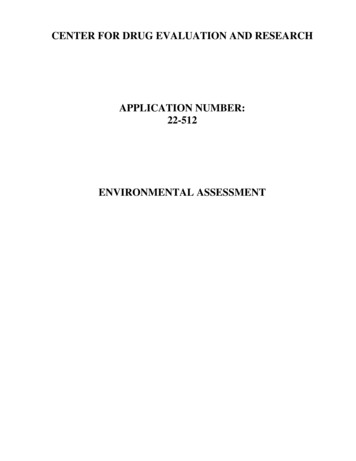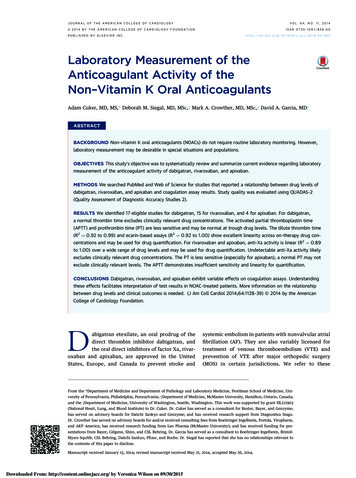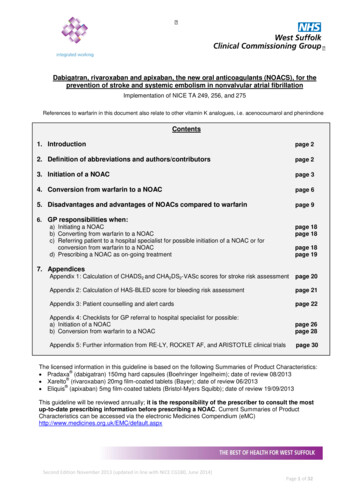
Transcription
Dabigatran, rivaroxaban and apixaban, the new oral anticoagulants (NOACS), for theprevention of stroke and systemic embolism in nonvalvular atrial fibrillationImplementation of NICE TA 249, 256, and 275References to warfarin in this document also relate to other vitamin K analogues, i.e. acenocoumarol and phenindioneContents1. Introductionpage 22. Definition of abbreviations and authors/contributorspage 23. Initiation of a NOACpage 34. Conversion from warfarin to a NOACpage 65. Disadvantages and advantages of NOACs compared to warfarinpage 96. GP responsibilities when:a) Initiating a NOACb) Converting from warfarin to a NOACc) Referring patient to a hospital specialist for possible initiation of a NOAC or forconversion from warfarin to a NOACd) Prescribing a NOAC as on-going treatmentpage 18page 18page 18page 197. AppendicesAppendix 1: Calculation of CHADS2 and CHA2DS2-VASc scores for stroke risk assessmentpage 20Appendix 2: Calculation of HAS-BLED score for bleeding risk assessmentpage 21Appendix 3: Patient counselling and alert cardspage 22Appendix 4: Checklists for GP referral to hospital specialist for possible:a) Initiation of a NOACb) Conversion from warfarin to a NOACpage 26page 28Appendix 5: Further information from RE-LY, ROCKET AF, and ARISTOTLE clinical trialspage 30The licensed information in this guideline is based on the following Summaries of Product Characteristics: Pradaxa (dabigatran) 150mg hard capsules (Boehringer Ingelheim); date of review 08/2013 Xarelto (rivaroxaban) 20mg film-coated tablets (Bayer); date of review 06/2013 Eliquis (apixaban) 5mg film-coated tablets (Bristol-Myers Squibb); date of review 19/09/2013This guideline will be reviewed annually; it is the responsibility of the prescriber to consult the mostup-to-date prescribing information before prescribing a NOAC. Current Summaries of ProductCharacteristics can be accessed via the electronic Medicines Compendium econd Edition November 2013 (updated in line with NICE CG180, June 2014)Page 1 of 32
1. IntroductionThis guideline has been produced to help identify those patients who are most likely to benefitfrom dabigatran, rivaroxaban or apixaban, and to provide advice on using these new drugs inthe safest possible manner. The guideline covers both newly identified AF patients and existingAF patients currently taking warfarin. It does not and should not over-ride the NICE TechnologyAppraisals 249, 256 and 275; a clinician may initiate dabigatran, rivaroxaban or apixaban for anypatient within the Technology Appraisals’ (TAs) criteria. The guideline includes the expert adviceand opinions of local clinicians following a detailed review of the NOAC clinical trial papers:RE-LY, ROCKET AF, and ARISTOTLE (see Appendix 5, p.30).For the purposes of this guideline, ‘non-valvular’ atrial fibrillation is defined as rhythmdisturbance occurring in the absence of rheumatic mitral stenosis or a prosthetic heart valve . ACC/AHA/ESC Guidelines for the Management of Patients with Atrial Fibrillation. Circulation 2001;104:2118-21502. Definition of abbreviations and onAtrial fibrillationStroke risk assessment: Cardiac failure, Hypertension, Age, Diabetes,Stroke (doubled)Extended stroke risk assessment: Congestive heart failure, Hypertension,Age 75 (doubled), Diabetes, Stroke (doubled), Vascular disease, Age 6574, Sex category (female)Estimated glomerular filtration rate [mL/minute/1.73m2] (taken to beapproximately 10mL/minute greater than the calculated creatinineclearance to provide a safety margin); degrees of renal impairment aredetailed in section 6 of this guideline (see p.19)Full blood countGastro-intestinalBleeding risk assessment: Hypertension, Abnormal renal/liver function,Stroke, Bleeding, Labile INR, Elderly, Drugs/alcoholLiver function testsNew oral anticoagulant (dabigatran, rivaroxaban, or apixaban)Summary of Product CharacteristicsTime in therapeutic rangeUrea and electrolytesNHS West Suffolk Clinical Commissioning GroupAuthorsLinda Lord – Head of Medicines Management, WSCCGEmma Harris – Medicines Management Pharmacist, WSCCGContributorsDr Abul Azim – Consultant in Elderly Medicine and Stroke, West Suffolk HospitalDr P Badrinath – Consultant in Public Health Medicine, Suffolk County CouncilDr Christopher Browning – GP Prescribing Lead, WSCCGDr Dipti Chitnavis – Consultant in Haematology, West Suffolk HospitalDr Emma Derbyshire – GP Prescribing Lead, WSCCGDr Claire Hughes – Consultant in Haematology, West Suffolk HospitalDr Zarif Jabbar-Lopez – FY2 Doctor in Public Health Medicine, Suffolk County CouncilKatie Johnson – Speciality Registrar in Public Health Medicine, Suffolk County CouncilDr Shubhada Sinha – Clinical Director for Acute Medicine, West Suffolk HospitalSimon Whitworth – Chief Pharmacist, West Suffolk HospitalThe WSCCG would like to thank the NHS Northamptonshire Prescribing Advisory Group and the East of England PrioritiesAdvisory Committee for sharing their papers on dabigatran and rivaroxaban.Second Edition November 2013 (updated in line with NICE CG180, June 2014)Page 2 of 32
3.Initiation of a NOACApplies to newly diagnosed AF patients and to existing AF patients who are not able to take warfarin. Oral anticoagulation is indicated for patients with a CHADS2 or a CHA2DS2-VASc score 2(see Appendix 1, p.20) Warfarin remains a suitable first-line option for patients who require an oralanticoagulant, particularly in those with:o eGFR 40Patients with a baseline eGFR of 40-50 are at risk of progressive/acute renal dysfunctionand the potential risks of bleeding with a NOAC should be weighed on an individual basiso a history of significant peptic ulcer diseaseo significant ischaemic heart diseasePhysicians should carefully consider whether NOACs are appropriate replacements for warfarin.Following prescribing guidelines and keeping a vigilant eye on medication safety literature shouldguide the management of individual patients receiving newly approved medications with potentiallife-threatening side effects.A NOAC can be offered as an alternative option to warfarin for the prevention of stroke andsystemic embolism provided that NICE criteria are satisfied (see Table 1a below). Furtherrecommendations are provided in Table 2a (p.4) to help identify those patients who are most likelyto benefit from a NOAC, and to provide advice on using the NOACs in the safest possible manner.Table 1aNICE criteria to be met when initiating a NOAC for the prevention of stroke and systemicembolism in AFDabigatran is an option if:Rivaroxaban is an option if:Apixaban is an option if:Nonvalvular AF and NICE TANonvalvular AF and NICE TANonvalvular AF and NICE TA249 criteria are satisfied, i.e. one 256 criteria are satisfied, i.e.275 criteria are satisfied, i.e.or more of the following riskone or more risk factors suchone or more risk factors suchfactors:as:as: Previous stroke, TIA or Congestive heart failure Prior stroke or TIAsystemic embolism Hypertension Age 75 years or older Left ventricular ejection Age 75 years or older Hypertensionfraction below 40% Diabetes mellitus Diabetes mellitus Symptomatic heart failure of Prior stroke or TIA Symptomatic heart failureNew York Heart Associationclass 2 or above Age 75 years or older Age 65 years or older withone of the following: diabetesmellitus, coronary arterydisease or hypertensionNICE TAG 249 (dabigatran): sm-in-atrial-fibrillation-ta249NICE TAG 256 (rivaroxaban): ple-with-atrial-fibrillation-ta256NICE TAG 275 (apixaban): onvalvular-atrial-fibrillation-ta275Second Edition November 2013 (updated in line with NICE CG180, June 2014)Page 3 of 32
A clinician may choose to prescribe a NOAC for any patient who satisfies the relevant NICE TAcriteria, however, careful consideration of the points in Table 2a are strongly recommended.Table 2aFurther recommendations to consider when initiating a NOAC for the prevention of strokeand systemic embolism in AFIt is recommended that:1. CHADS2 or CHA2DS2-VASc score 2 (see Appendix 1, p.20)2. eGFR 40 for dabigatran; eGFR 25 for rivaroxaban; eGFR 25 for apixaban. Dabigatran is principally renally excreted; doses may therefore accumulate and increase therisk of bleeding. Dabigatran is contraindicated in patients with creatinine clearance 30mL/min; in patientswith creatinine clearance 30-50mL/min the dose of dabigatran (150mg twice daily or 110mgtwice daily) should be selected based on an individual assessment of both thromboembolicand bleeding risk. Rivaroxaban is not recommended if creatinine clearance 15mL/min. It should be used withcaution in patients with creatinine clearance 15-29mL/min; in patients with creatinineclearance 15-49mL/min, a low dose of 15mg once daily is recommended. Apixaban is not recommended if creatinine clearance 15mL/min. A low dose of 2.5mgtwice daily is recommended in patients with creatinine clearance 15-29mL/min, or with aserum creatinine 133micromole/L associated with age 80 years or bodyweight 60kg, orin patients with at least two of the following characteristics: age 80 years, body weight 60kg, or serum creatinine 133micromole/L. Extreme caution is advised when prescribing a NOAC to a patient with any degree of renalimpairment (particularly if eGFR 50). The half-lives of the NOACs can be significantlyprolonged in patients with renal impairment and doses may accumulate; patients who areacutely unwell can deteriorate very quickly. Prescribers should also be alert to the risks associated with using the NOACs in the eventof an acute decline in renal function due to an acute co-morbidity (e.g. dehydration, shock,or the initiation of nephrotoxic medicines such as NSAIDs, ACE inhibitors, oraminoglycosides).3. No history of significant peptic ulcer disease. Low dose dabigatran (110mg twice daily) is not known to cause an increase in theincidence of GI bleeding compared to warfarin, but it is associated with increased GI sideeffects. In patients with gastritis, oesophagitis, or gastro-oesophageal reflux, the dose of dabigatran(150mg twice daily or 110mg twice daily) should be selected based on an individualassessment of both thromboembolic and bleeding risk. Rivaroxaban is associated with more GI bleeding than warfarin. There is no difference in the frequency of GI bleeds with apixaban compared to warfarin. NOACs should usually be avoided in patients with a history of peptic ulcer disease due tothe increased risk of bleeding.4. No significant ischaemic heart disease. A small but significant increased risk of myocardial infarction (MI) was seen in trials withdabigatran standard dose (150mg twice a day) compared with warfarin, which may reflect apossible clinical benefit of warfarin. The long term effects of NOACs with regard to MI are not known and it is therefore advisedthat all NOACs should be avoided in patients with significant ischaemic heart disease.Continued on next pageSecond Edition November 2013 (updated in line with NICE CG180, June 2014)Page 4 of 32
Table 2a continued5. At least one of these: Warfarin is contraindicated. Venous access for INR monitoring is not possible. There are insurmountable difficulties with safe compliance of INR monitoring and doseadjustments, e.g. due to cognitive impairment. HAS-BLED score 3 (see Appendix 2, p.21), where apixaban or low-dose dabigatran(110mg twice daily) may be appropriate. Apixaban and low-dose dabigatran are associatedwith a reduced risk of major bleeding. Warfarin has been stopped due to intolerance, poor response, or a significant bleed whiletaking warfarin. Apixaban and low-dose dabigatran are associated with a reduced risk ofmajor bleeding.6. No other contraindications.The current SPCs containing the full contraindications for Pradaxa (dabigatran etexilate),Xarelto (rivaroxaban), and Eliquis (apixaban) can be accessed via the electronic MedicinesCompendium (eMC) http://www.medicines.org.uk/EMC/default.aspx7. The special warnings, precautions, and drug interactions that apply have been considered.The current SPCs containing the full special warnings, precautions and drug interactions forPradaxa (dabigatran etexilate), Xarelto (rivaroxaban), and Eliquis (apixaban) can beaccessed via the electronic Medicines Compendium . An informed discussion has taken place between the clinician and the patient about the risksand benefits of NOACs compared to warfarin. Refer to Tables 3a (p.9) and 3b (p.12).Second Edition November 2013 (updated in line with NICE CG180, June 2014)Page 5 of 32
4. Conversion from warfarin to a NOACApplies to existing AF patients who are currently prescribed warfarin. Warfarin remains a suitable first-line option for patients who require an oralanticoagulant, particularly in those who are currently well controlled and tolerant ofwarfarinPhysicians should carefully consider whether NOACs are appropriate replacements for warfarin.Following prescribing guidelines and keeping a vigilant eye on medication safety literature shouldguide the management of individual patients receiving newly approved medications with potentiallife-threatening side effects.Conversion to a NOAC is an alternative option to warfarin for the prevention of stroke andsystemic embolism provided that NICE criteria are satisfied (see Table 1b below). Furtherrecommendations are provided in Table 2b (p.7) to help identify those patients who are mostlikely to benefit from a NOAC and to provide advice on using the NOACs in the safest possiblemanner.Table 1bNICE criteria to be met when converting from warfarin to a NOAC for the prevention ofstroke and systemic embolism in AFConversion to dabigatranConversion to rivaroxaban Conversion to apixabanis an option if:is an option if:is an option if:Nonvalvular AF and NICE TANonvalvular AF and NICE TA Nonvalvular AF and NICE TA249 criteria are satisfied, i.e.256 criteria are satisfied, i.e.275 criteria are satisfied, i.e.one or more of the followingone or more risk factors such one or more risk factors suchrisk factors:as:as: Previous stroke, TIA or Congestive heart failure Prior stroke or TIAsystemic embolism Hypertension Age 75 years or older Left ventricular ejection Age 75 years or older Hypertensionfraction below 40% Diabetes mellitus Diabetes mellitus Symptomatic heart failure Prior stroke or TIA Symptomatic heart failureof New York HeartAssociation class 2 orabove Age 75 years or older Age 65 years or older withone of the following:diabetes mellitus, coronaryartery disease orhypertensionNICE TAG 249 (dabigatran): sm-in-atrial-fibrillation-ta249NICE TAG 256 (rivaroxaban): ple-with-atrial-fibrillation-ta256NICE TAG 275 (apixaban): onvalvular-atrial-fibrillation-ta275Second Edition November 2013 (updated in line with NICE CG180, June 2014)Page 6 of 32
A clinician may choose to prescribe a NOAC for any patient who satisfies the NICE TA criteria,however, careful consideration of the points in Table 2b are strongly recommended.Table 2bFurther recommendations to consider when converting from warfarin to a NOAC for theprevention of stroke and systemic embolism in AFIt is recommended that:1. CHADS2 or CHA2DS2-VASc score 2 (see Appendix 1, p.20).2. eGFR 40 for dabigatran; eGFR 25 for rivaroxaban; eGFR 25 for apixaban. Dabigatran is principally renally excreted; doses may therefore accumulate and increasethe risk of bleeding. Dabigatran is contraindicated in patients with creatinine clearance 30mL/min; in patientswith creatinine clearance 30-50mL/min the dose of dabigatran (150mg twice daily or110mg twice daily) should be selected based on an individual assessment of boththromboembolic and bleeding risk. Rivaroxaban is not recommended if creatinine clearance 15mL/min. It should be usedwith caution in patients with creatinine clearance 15-29mL/min; in patients with creatinineclearance 15-49mL/min a low dose of 15mg once daily is recommended. Apixaban is not recommended if creatinine clearance 15mL/min. A low dose of 2.5mgtwice daily is recommended in patients with creatinine clearance 15-29mL/min, or with aserum creatinine 133micromole/L associated with age 80 years or bodyweight 60kg, orin patients with at least two of the following characteristics: age 80 years, body weight 60kg, or serum creatinine 133micromole/L. Extreme caution is advised when prescribing a NOAC to a patient with any degree of renalimpairment (particularly if eGFR 50). The half-lives of the NOACs can be significantlyprolonged in patients with renal impairment and doses may accumulate; patients who areacutely unwell can deteriorate very quickly. Prescribers should also be alert to the risks associated with using the NOACs in the eventof an acute decline in renal function due to an acute co-morbidity (e.g. dehydration, shock,or the initiation of nephrotoxic medicines such as NSAIDs, ACE inhibitors, oraminoglycosides).3. No history of significant peptic ulcer disease. Low dose dabigatran (110mg twice daily) is not known to cause an increase in theincidence of GI bleeding compared to warfarin, but it is associated with increased GI sideeffects. In patients with gastritis, oesophagitis, or gastro-oesophageal reflux the dose of dabigatran(150mg twice daily or 110mg twice daily) should be selected based on an individualassessment of both thromboembolic and bleeding risk. Rivaroxaban is associated with more GI bleeding than warfarin. There is no difference in the frequency of GI bleeds with apixaban compared to warfarin. NOACs should usually be avoided in patients with a history of peptic ulcer disease due tothe increased risk of bleeding.4. No significant ischaemic heart disease. A small but significant increased risk of myocardial infarction (MI) was seen in trials withdabigatran standard dose (150mg twice a day) compared with warfarin, which may reflecta possible clinical benefit of warfarin. The long term effects of NOACs with regard to MI are not known and it is thereforeadvised that all NOACs should be avoided in patients with significant ischaemic heartdiseaseContinued on next pageSecond Edition November 2013 (updated in line with NICE CG180, June 2014)Page 7 of 32
Table 2b continued5. At least one of these: Patient compliant with warfarin treatment, yet TTR 65% after 6 months. TTR figures areavailable from anticoagulant clinics. History of a significant bleed on warfarin with CHADS2 or CHA2DS2-VASc score 1 (seeAppendix 1, p.20), where apixaban or low-dose dabigatran (110mg twice daily) may beappropriate. Apixaban and low-dose dabigatran are associated with a reduced risk ofmajor bleeding. History of ischaemic stroke or TIA while patient compliant with warfarin treatment, whereapixaban or standard-dose dabigatran (150mg twice daily) may be appropriate. Apixabanor standard-dose dabigatran may be more effective than warfarin in preventing strokes inpatients with AF. Concurrent regular use of medicines that continue to cause wide INR fluctuation after a 3month trial of warfarin, despite increased INR testing and warfarin dose adjustments.Interacting drugs can be co-prescribed with warfarin with care.For short courses of a new interacting drug, warfarin dose adjustment is not essential; for a drugchange lasting 7 days, an INR test should be performed 3-7 days after starting the new medicineso that the warfarin dose can be adjusted on the basis of the INR result. [The British Committee forStandards in Haematology guidelines on oral anticoagulation with warfarin—fourth edition. Br JHaem 2011; 154 (3): 311-324]. HAS-BLED score 3 (see Appendix 2, p.21), where apixaban or low-dose dabigatran(110mg twice daily) may be appropriate. Apixaban and low-dose dabigatran areassociated with a reduced risk of major bleeding. Venous access for INR monitoring is difficult (consider using a finger prick near-patienttesting device). Increasing difficulties with safe compliance of INR monitoring and dose adjustments, e.g.due to cognitive impairment.6. No other contraindications.The current SPCs containing the full contraindications for Pradaxa (dabigatran etexilate),Xarelto (rivaroxaban), and Eliquis (apixaban) can be accessed via the electronic MedicinesCompendium (eMC) http://www.medicines.org.uk/EMC/default.aspx7. The special warnings, precautions, and drug interactions that apply have been considered.The current SPCs containing the full special warnings, precautions and drug interactions forPradaxa (dabigatran etexilate), Xarelto (rivaroxaban), and Eliquis (apixaban) can beaccessed via the electronic Medicines Compendium . An informed discussion has taken place between the clinician and the patient about the risksand benefits of NOACs and warfarin. Refer to Tables 3a (p.9) and 3b (p.12).Second Edition November 2013 (updated in line with NICE CG180, June 2014)Page 8 of 32
5. Disadvantages and advantages of NOACs compared to warfarinThe information provided in Table 3a should be used to enable an informed discussion to takeplace between clinician and patient regarding appropriate initiation of a NOAC. Table 3b (p.12)provides similar information, but is formatted to directly compare dabigatran, rivaroxaban,apixaban, and warfarin.Table 3a: Disadvantages and advantages of NOACs compared to warfarinDisadvantages NOACs are new drugs with a lack of long-term safety data; apixaban is a ‘black triangle’drug. Warnings by the regulatory bodies continue to be issued. No specific antidote for the NOACs. Urgent medical attention is needed if the patient falls or suffers injury, particularly if theirhead is injured, due to the risk of bleeding. This also applies to warfarin however theanticoagulant effect of warfarin can be reversed, while the reversibility of NOACanticoagulation is difficult and uncertain. No difference in efficacy of stroke prevention for rivaroxaban or dabigatran low-dose(110mg twice daily), compared to warfarin. The standard dose of dabigatran (150mg twice a day) was associated with a small butsignificant increased risk of MI, which may reflect a clinical benefit of warfarin. For every476 people on dabigatran standard dose (150mg twice daily), one additional MI wasobserved. Dabigatran standard dose (150mg twice daily) and rivaroxaban have a higher risk of GIbleeding. Rivaroxaban was associated with increased major GI bleeding compared towarfarin. Dabigatran (both doses) and rivaroxaban are both associated with increased GIside effects. There was no difference in the frequency of GI bleeds with apixabancompared to warfarin. There is a risk of treatment failure unless patient compliance with NOAC treatment isconsistently good. The half-life of dabigatran is 12-14 hours (if normal renal function). Thehalf-life of rivaroxaban is 5-9 hours in young patients, and 11-13 hours in the elderly. Thehalf-life of apixaban is 12 hours. Compliance is critical as protection from stroke will belost with the omission of only one dose of a NOAC (in contrast to warfarin which has ahalf-life of 40 hours). The NOAC half-lives can be significantly prolonged in patients withrenal impairment and doses may accumulate. Dabigatran should be avoided if creatinine clearance 30mL/min. Rivaroxaban should beavoided if creatinine clearance 15mL/min and should be used with caution if creatinineclearance 15-29mL/min. Apixaban is not recommended if creatinine clearance 15mL/min, and a low dose of 2.5mg twice daily is recommended in patients withcreatinine clearance 15-29mL/min, or with a serum creatinine 133micromole/Lassociated with age 80 years or bodyweight 60kg, or in patients with at least two of thefollowing characteristics: age 80 years, body weight 60 kg, or serum creatinine 133micromole/L. Extreme caution is advised when prescribing a NOAC to a patient with any degree ofrenal impairment (particularly if eGFR 50). The half-lives of the NOACs can besignificantly prolonged in patients with renal impairment and doses may accumulate;patients who are acutely unwell can deteriorate very quickly. In clinical trials, more patients stopped taking dabigatran and rivaroxaban than warfarinbecause of side effects. Dabigatran (both doses) caused more GI symptoms thanwarfarin, e.g. dyspepsia, whereas rivaroxaban caused more nose bleeds and haematuriathan warfarin. Problems can arise if unplanned surgery or procedures are needed;o Apixaban: stop at least 48 hours prior to elective surgery or invasive procedureswith a moderate or high risk of bleeding, or at least 24 hours prior to theprocedure if there is a low risk of bleeding. If surgery or invasive proceduresContinued on next pageSecond Edition November 2013 (updated in line with NICE CG180, June 2014)Page 9 of 32
Table 3a continuedoocannot be delayed, appropriate caution should be exercised, taking intoconsideration an increased risk of bleeding. This risk of bleeding should beweighed against the urgency of intervention.Rivaroxaban: stop at least 24 hours prior to surgery or invasive procedure. If theprocedure cannot be delayed the increased risk of bleeding should be assessedagainst the urgency of the intervention.Dabigatran: the manufacturer gives the following discontinuation rules for invasiveor surgical procedures:Renalfunction(CrCL inmL/min)Estimatedhalf-life(hours) 80Stop dabigatran before elective surgeryHigh risk of bleeding ormajor surgeryStandard risk 132 days before24 hours before 50 - 80 152-3 days before1-2 days before 30 - 50 184 days before2-3 days before( 48 hours)If an acute intervention is required, dabigatran should be temporarily discontinuedand the procedure should be delayed if possible until at least 12 hours after thelast dose—if surgery cannot be delayed the risk of bleeding may be increased,and this risk of bleeding should be weighed against the urgency of theintervention. No clearly defined mechanism by which to determine if the NOACs are workingeffectively in individual patients (because the INR cannot be tested), therefore makingcompliance difficult to monitor.Rivaroxaban and apixaban cannot be dialysed.Dabigatran and apixaban must be taken twice daily, so there is potential for lowercompliance.Dabigatran cannot be crushed or administered by nasogastric tube; there is no data onwhether or not apixaban is suitable for crushing or administration via nasogastric tube(though it is not a pro-drug like dabigatran).Dabigatran and warfarin are not suitable for monitored dosage systems; there is no dataon whether or not apixaban is suitable for a monitored dosage system (though it is not apro-drug like dabigatran).No data on rivaroxaban or apixaban in cardioversion.Rivaroxaban should not be prescribed for patients with hepatic disease associated withcoagulopathy and clinically significant bleeding risk, including cirrhotic patients with ChildPugh B and C. Dabigatran should be avoided in liver disease, hepatic impairmentexpected to have any impact on survival, or elevated liver enzymes 2 times the upperlimit of normal. However, any anticoagulant should be used with caution if coagulopathyis evident. Apixaban is contraindicated in patients with hepatic disease associated withcoagulopathy and clinically relevant bleeding risk. Apixaban is not recommended inpatients with severe hepatic impairment and should be used with caution in patients withmild or moderate hepatic impairment, and in patients with elevated liver enzymes(ALT/AST 2 x upper limit of normal) or total bilirubin 1.5 x upper limit of normal.The NOACs are more expensive than warfarin. Dabigatran costs 802/year, rivaroxaban 766/year, and apixaban 802/year; warfarin costs 380/year. Costs may vary indifferent settings because of negotiated procurement discounts. The cost of INRmonitoring in Suffolk is covered by a block contract.Widespread use will cause very significant cost pressures on the Suffolk healthcaresystem, particularly since the warfarin monitoring service will need to be maintained forthe foreseeable future.Second Edition November 2013 (updated in line with NICE CG180, June 2014)Page 10 of 32
AdvantagesThe NOACs may be suitable for patients who cannot tolerate warfarin.The NOACs may be suitable for patients who are compliant with warfarin, and yet are notwell controlled (TTR 65%).No INR monitoring is required for the NOACs, so they may be more convenient forpatients who travel regularly for extended periods of time.The NOACs may be useful for rapid anticoagulation following TIA only in certain high riskpatients.The NOACs have fewer drug and food interactions compared to warfarin.Dabigatran can be dialysed (however extreme caution is advised when performing thisinvasive catheter procedure on an anticoagulated patient).Dabigatran standard dose (150mg twice daily) is statistically significantly more effectivein preventing stroke, particularly haemorrhagic stroke, in people with AF with a moderate/high risk of stroke, compared to warfarin. The number needed to treat to prevent onesystemic embolism or stroke per year is 172.Apixaban is statistically significantly more effective in preventing stroke and systemicembolism compared to warfarin. The number needed to treat for one year to p
Dabigatran, rivaroxaban and apixaban, the new oral anticoagulants (NOACS), for the prevention of stroke and systemic embolism in nonvalvular atrial fibrillation Implementation of NICE TA 249, 256, and 275 References to warfarin in this document also relate to other vitamin K analogues, i.e. acenocoumarol and phenindione d) 7. Appendix 1: Calculatio


